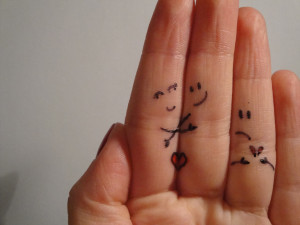Any writer knows there’s no right or wrong way to start telling your story. You’ll hear writers talk about outlining versus little-to-no outlining; some prefer to do detailed outlines while some (like me) do their best work when writing on-the-fly. You don’t hear quite as much talk, though, about the order of creating characters and story.
Why is that? I would guess the main reason behind it is it’s just not really as common an argument. Is there an order? As far as writing dos and don’ts, it’s not really the most critical thing in the world whether you write your characters around your story or create your characters first. It’s kind of like the chicken or the egg dilemma. Sure, it’s fun to think about, but it doesn’t really matter which came first, so long as you end up with the chicken. Or does it?
Hey, end up with a solid story and memorable characters, and you’ve got it made. If you’re an experienced writer, as long as your end result has a story and some good characters, you usually don’t think too much about the process after the fact. I finished my book, whoohoo…! That’s all that’s really on your mind.
But because I’m big on characters and tend to develop them before story, I started thinking. Maybe it does matter.
I’ve put years into studying my favorite characters and creating my own because…well, I love characters. They’re my reason for reading, watching, or playing anything. You might have heard me say that I won’t spend much time reading, watching, or playing anything unless I’m attached to the characters. The less attached I am, the easier it will be for me to stop reading, stop watching, or stop playing. I’ve watched some real bad and quirky shows because I just wouldn’t give up on the characters, and by that same token I’ve given up on some pretty decent stories because I just did not love the characters. Characters are everything because we see aspects of ourselves in our favorite characters.
So because characters are so important, I genuinely believe that taking the time to develop them first is worth thinking about – especially if you’re a new writer. While a good story and a solid plot do help, well-developed characters do wonders to help carry a story forward. How do you go about creating a dynamite cast of characters for your story?
Experienced and established writers will have a pretty good idea of what’s involved, but if you’re fairly new to writing, or just looking to deepen or enhance your own characters, here’s a starter checklist for building a solid character foundation:
- Motivation or Desire. What does your character want more than anything else in the world? If this is your Main Character, the core of your story will be driven by this motivation or desire. If it’s a secondary or minor character, it’s still just as important because they will be propelled by their desires too, and drive any sub-plots. There’s a secondary element to this though – a character’s motivation/desire will be split between an outer desire and inner desire. There is sometimes a big difference between what your character appears to want in the outside world and what he/she actually wants deep down inside of himself/herself.
Example: In FOX’s hit musical TV comedy, Glee, what primarily drives Rachel Berry (played by Lea Michele) is her desire to be a star. But underneath that outer desire is her deeper desire to just be loved and accepted for all her insecurities.
- Fears. This is the flip-side of your character’s motivations/desires. His/her fears could simply be the exact opposite of what they desire – in Rachel Berry’s case, her underlying fear of not being good enough to become a star – or it might not be directly related but more of a deep-seated fear that drives them further from their ultimate goal.
Example: In Disney’s The Lion King, Simba’s desire more than anything was to one day be king; his fear more than anything is that he will be found out and disowned for, in his mind, “killing his father”. (When Scar null and voids his desire by making him believe the “accident” was his fault, Simba is then driven solely by his fear – and so runs away, leading him further away from his desire of becoming king.)
- Background Story. Every character has a background story, some more than others. While it’s not the most important building block for your character (that goes to motivation/desire), it does play a major role in defining your character and what they’re all about – their thoughts, their hopes, their dreams. Your character’s childhood, heritage, beliefs, environment…just their life in general, will all impact how he/she perceives their world. Just like no one else thinks like you do, no one else will think like your character. His/her background story will influence who your character is and how he/she feels about life.
Example: In the Peter books – a paranormal series written by an author friend of mine – Peter leaves a life of child pornography behind him and starts a new life with his foster family. But his past never leaves him, it becomes a part of him – his actions, his thoughts…his beliefs about himself and the people around him. Even though Peter discovers he’s a werewolf about mid-way through the first book, his character’s mentality, emotions, and very way of being are shaped as much by his disturbing and violent upbringing as it is by his lycanthrope DNA.
- Relationships. Each character might be his/her own individual, but a character really gets interesting when looked at through his/her relationships to other characters. You know how we’re often judged or perceived by the friends we hang around? Or even just how you start to act like your friends after a while? Just as you can tell a lot about a person by who they associate with, you can tell a lot about a character by their relationships – who they talk to, who they think about, who they love, who they hate, their friends, their family…. It’s a powerful tool to understanding who your characters – or anybody’s characters – really are.
Example: In Jhonen Vasquez’s Invader Zim, most of how we understand and relate to the two main characters – Zim the alien and Dib the human – is through their love/hate relationship toward each other. Their love/hate relationship is so central to any and all plots that without it, the entire story would fall apart.
Feel free to add one of your own to my checklist in a comment below! What’s your own personal method for creating characters – characters first, or story first?
Image belongs to: {C}hristina on Flickr


